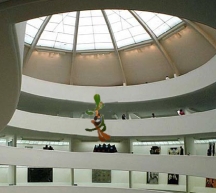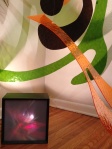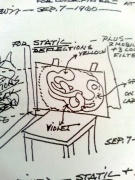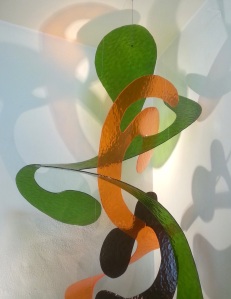
As a collector of mid century modern design and art it is uncommon to come across an accomplished body of work and know nothing of it or the person. What makes the discovery of Jim Davis’s work startling is the eventual understanding, after just a brief study of what an impact he had on the arts in the two diverse worlds of modern art and avant-garde film. Davis had a large impact on the artists he taught and the artists he collaborated with, including individuals whose names are known by virtually all lovers of mid century modern design and avant-garde film making. His contributions to the “Lumia” art movement was immense.
Mies Van Der Rohe, Frank Lloyd Wright, Alien Saarinen, Alexander Calder, Joan Miro, Martha Graham, Peggy Guggenheim, David Rockerfeller, Laszlo Moholoy-Nagy, John Marin, Stan Brakhage – even the entire French Film Industry of the 50’s are just some of the people who were were influenced by Jim Davis or his patrons. Not to mention the thousands of students and artists of Princeton who he taught or viewed his works. His work appeared in the opening exhibit at MOMA in 1932, he was one of the trio of people hired to open Princeton’s Dept. of Art and Architecture, he was the sole filmmaker for Frank Lloyd Wright and John Marin, he was one of the first American avant-garde filmmakers and a primary influence on the celebrated filmmaker Stan Brakhage, who dedicated his first film to Davis. Sadly, through a confluence of factors he almost became forgotten to modern audiences.
Thanks to the diligence and hard work of the head curator of Anthology Film Archives New York (Robert A. Haller), Jim Davis work has been preserved and his body of work brought to light. I must concur with Mr. Haller that to not know of Davis and his impact, would be to not know a piece of the puzzle that shapes our modern world.
It seems odd in our age when it seems all things are recorded and documented, even the most trivial, that the omission of an important artist could occur. Jim Davis’s personality, his intense privacy, poor distribution of his films at a critical time coupled with declining health during the late 1960’s when the importance of avant-garde films was being recognized and appreciated are the root causes contributing to his obscurity. But this is rapidly changing.

Recently discovering Jim Davis’s work I feel almost an obligation to inform others of who this man and his art. Considering his body of work and incredible accomplishments it is hard to reconcile how he isn’t mentioned a great deal more across broad spectrum of the art and film worlds.
It is not possible – even in summary – in a blog post to mention just the simple accomplishments or effects this man had on others & modernism. Nor is it possible to competently paraphrase the wealth of information contained in wonderful books by curator Robert A. Haller. (Dancing with light: The films of Jim Davis, Notes on John Marin and Frank Lloyd Wright by Jim Davis Edited by Robert A. Haller or The Flow of Energy by Jim Davis with introduction by Robert A. Haller).
So instead I will introduce you to just one aspect of Jim Davis’s body of work: His last sculpture & the influences behind it’s creation (including a rare piece of equipment he used known as a “light modulator”). To give the reader some context I will provide a brief, incomplete timeline of Jim Davis’s life:
- Jim Edward Davis, born 1901 in Clarksburg, WV and died 1974 in Princeton, NJ.
- Studies Arts, particularly painting and drawing in both the United States & in Europe. His work shows the distinct influence of cubism.
- Graduates from Princeton in 1923 with a MFA degree. Moves to NYC and begins exhibiting his abstract-expressionist paintings.
- Among the first group of artists selected for the opening exhibition at the Museum of Modern Art 1932.
- Teaches at Princeton University several times lastly 1936-1942 in the School of Architecture & within the department of Art & Archaeology. Was In Charge of the Painting Section of the “Creative Arts Program”, after which he leaves permanently to pursue his fascination and experimentation with light modulators and films.
- Painting & Sculpting are his primary areas of expression until the 1940’s when he commences experiments with plastic “Light Modulators”.
- Briefly in the mid 1940’s, before turning to film, holds live exhibition showings of his light modulators, in 1947 at Frank Lloyd Wright’s request a private showing is performed. Wright entranced by his new ideas, approaches Davis and a great friendship ensues. Frank Lloyd Wright entrusts filming of private residence at Taliesin West to Davis, something that he had never allowed previously.

- Frank Lloyd Wright attempts to have the light modulators of Jim Davis included in his design of the Guggenheim Museum. James Sweeney and Frank Lloyd Wright have an antagonistic relationship that peaks with the disagreement regarding the lighting. The building is finalized, completed and opened after Frank Lloyd Wright passes. The Light Modulators are not employed.
- From notes, letters and correspondence it is strongly suggested Frank Lloyd Wright saw Jim Davis’s light sculptures & modulators as a step beyond what Calder had created, but Calder had momentum, popularity, people involved at the Guggenheim and commerce on his side – something Jim Davis purposefully avoided and held low regard for. Davis was dedicated to his filming at all costs. It is speculated that perhaps these light modulators were seen as works of art rather than lighting aids, and would therefore qualify as “permanent structural art” which would violate the principle of the building as an exhibition space. It is obvious there was a force behind Calder helping to push his Mobiles to the forefront, even though they are different art forms & are not comparable. In 1947 Wright (where he had a private viewing of the modulators after declaring all else at Princeton “not worth seeing”) stated he would have the Baroness Rebay see them, and to have the modulators incorporated into the Solomon R. Guggenheim museum stating “this makes everything else obsolete and out of date…”
-

Jim Davis Light Modulator with low powered illumination. Peggy Guggenheim herself was so entranced by the Light Modulators, she commissions a piece from Jim Davis based on a modulator, but requested it executed in a larger size from Davis for her own collection. We are currently investigating the whereabouts of this sculpture. Frank Lloyd Wright heralds Davis’s work throughout the following years in, for Wright, a very rare case of appreciation, endorsement and herald for another artist’s work.
- 1946 until his death in 1974 Davis devotes himself almost solely to creating films using light modulators. The only two exceptions we are aware of so far is the commissioned light sculpture to Peggy Guggenheim (no further details are available currently), and for a commission in the late 1960’s to design a large mobile titled “4th Dimension” for Mr. James Brown III, the President of the WV Building & Loan Association (who was related to Davis by marriage to niece) for the building designed by mid century modern architect Henry Elden in Charleston, WV. At 7 feet tall, it is the largest known example of his work.
- 1940: Meets Painter John Marin and a lasting friendship ensues with each one effecting each the others work. Marin would then in the 50’s entrust only Davis to filming his works.
-

Laszlo Moholy-Nagy 1945. Last sculpture prior to his passing in 1946. 1945 – Meets Laszlo Moholy-Nagy, the make a mutual deep impression with each other. Moholy-Nagy instantly adopted the methods of dye and coloring of plastics developed & discovered by Jim Davis which had eluded him for years. If not for Moholy-Nagy’s death there is no doubt his sculptures from would have been forever altered after their friendship, and Davis’s work was forever altered by the meeting. Most appealing to Moholoy-Nagy were the light modulators, just as they had captivated Wright, and many others, who saw them as a new art medium to be explored and developed. It’s interesting to note that the last sculpture created by Moholy-Nagy in 1946, shortly before his death seems to deploy methods of coloring and etching plastics which had been known by Davis since the 30’s and imparted to Moholy-Nagy at this time.
- 1948: Skidmore, Owens, Merrill (SOM) Architects commission Alexander Calder, Joan Miro, Saul Steinberg & Jim Davis to create art and sculptures for the famous Terrace Plaza Hotel in Cincinnati. Jim Davis creates three light sculptures almost identical to his light modulators which were lighted and displayed in the hotel’s cafe. Later along with other art and pieces from this famous hotel through mismanagement and failure to maintain and preserve, are ultimately lost forever.

1948, Cincinnati Terrace Plaza Hotel, Cocktail Lounge with Light Sculptures by Jim Davis. - During the 40’s, 50’s, 60’s and 70’s Jim Davis’s films are shown and exhibited in many countries and win numerous awards. During the 1950’s he would become very prominent in the avant-garde film industry and become exceptionally prominent in European film circles particularly in France with noted followers such as Stan Brakhage who is forever altered by his friendship with Davis and it is Brakhage’s driving force that is primarily responsible for the materials we have today available and in archives.
His Beginnings & Pioneering in Lumia:
Davis experienced a profound event in the 1940’s during an illness. During that episode Davis observed images of light refraction and distortion through sunlight hitting and refracting from glass which he would forever attempt to re-create via his art. He concluded such images could only be recorded and communicated through film. Thus, it was the creation of the light modulators and experiments with dyes, pigments and colored acetate that would see him first create these images which would then later be made into dynamic, abstract films.
It is interesting to note that the first pioneer of Lumia was Thomas Wilfred (born Richard Edgar Lovstrom) and in effect, Davis was one of dozens who explored Lumia art forms. One notable (well known) artist is Earl Reiback and we can see a very similar creation from Reiback in his creations to those of Jim Davis – although Davis’s work predates Reiback’s by almost 20 years. In fact so similar are the images produced one has to wonder if they moved in the same circles. The creation of the Lumia Art Box for Lightolier produces images so similar to Davis’s films of the 50’s that at first glance I thought I was watching a Jim Davis film when I turned on the Lightolier Art Box.


What makes Jim Davis’s work stand out from other Lumia artists is his insistence to capture the art-form in film. Reiback, Wilfred and other lumia artists were of the thought that even with movie production equipment available at the time that the ability to capture the true essence of lumia was impossible – and said in so much that this was the case and both Reiback and Wilfred abandoned any attempt to do so. Jim Davis would find a way to do this and would spend decades in accomplishing this feat. It is this insistence from Davis to be a true avant-garde film maker that saw him possibly capture the art in recorded film.
It is highly interesting the similarities of why these artists attempted lumia – they all seem to have in common a wish to move away from the static form and create something that never repeats in their lumia creations and interviews with all the major lumia artists echo the same goals and dreams. Davis worked tirelessly on exposure settings and operation of the film equipment to capture the intensity and smooth movement of the images which he seems to have accomplished.
What is a light Modulator?
To explain what a light modulator is, is no easy task. Essentially it is a device that is designed to twist and distort light into ribbons and shapes, essentially we are seeing the light modulator alter states of energy into other forms which are visible. These modulators are created with clear and colored materials (usually acrylic); they are often complex containing dozens and sometimes over 100 facets on their edges. Extremely high powered light is employed – lamps up to 1000 watts of power are used to pass through the device, thus modulating the light.

In every instance the light must first transfer through light filters (usually three, often of Plexiglas or transparent acetate) before hitting the modulator. Usually, but not always, the modulator rotates on a string, the light filter discs rotated across the light sources in alternating colors (and sometimes there are more than one light modulator or filter sets). The images created are exceptionally complex and the cinema world had never seen anything like it before. Organic, abstract, colorful, biomorphic and indescribable. These set-ups were exceptionally time consuming and intricate with the positioning requiring exceptional precision. By themselves the light modulators are sculptures, but intended by Davis to be a medium to create even grander, dynamic art.

There are virtually no known examples of these “Light Modulators” except in the archives of Anthology films, The Guggenheim collection and we know that Davis also gifted some of these sculptures to a few close friends and family.
Davis would tell you see is what you get and there is absolutely no purposeful message or implied vision, but there is one constant and that is the conversion of energy into another form of energy – and your observation of that new form of energy.

We are exceptionally fortunate to have one of these light modulators which he gifted to a relative. This rare example was used in one of his films, but as to which film is impossible to say as the effects of the modulators are filmed and not the modulators themselves (with the exception of one film where he actually filmed the modulator being used as well).

Alexander Calder Mobiles & Jim Davis Light Sculptures.
The two knew each other well and had worked on the Terrace hotel together, and during the construction of the Guggenheim also. In addition to this there was photography performed in various studio locations for Frank Lloyd Wright incorporating Calder’s work. Of Jim Davis’s work, Frank Lloyd Wright saw it as a step beyond what was extant and even recent including Calder’s – although Calder was not attempting to create what Davis was and it would seem (to Davis’s frustration) that his and Calder’s work were compared at all.
Jim Davis sought to create motion in his sculptures and effects that constantly changed and Frank Lloyd Wright saw this also as ground-breaking. Davis was certain the future of art was not in fixed static forms, thus while appreciating Calder’s work it is clear that Jim Davis saw it as an extension of what was and not venturing into a territory.
Calder’s mobiles were comprised of 2 dimensional objects which while moved, did not change shape, whereas with Davis the sculptures actually changed with the light source moving because the sculptures were on several planes, not just two, and the emphasis was on the result. Wright favored the sculptures of Davis but with Davis holding onto the firm belief that he must film and not deviate saw him down play his own sculptures and refuse to enter into any form of commercial or patron production. This factor would make if difficult for Wright later to justify the insertion of Davis’s sculptures rather than Calder’s.

The Last Sculpture of Jim Davis.
It would be Davis’ relative’s fascination with the light modulator that he was gifted which would lead to him approach Davis in the late 1960’s to request he create a large scale mobile sculpture. The relative was a lawyer and president of a large bank, he was having a new bank built by modernist architect Henry Elden in Charleston, WV. He wanted a dynamic, and colorful piece of art to be prominently displayed in this new building and commissioned Davis to create it. (Davis did this as a special favor to a relative, and had not performed a sculpture commission in many years.)

The sculpture remained in place in the bank until the acquisition of the business in 1988. After the bank was sold the property was within a few years raised to the ground. The amazing modern structure was torn down for a chain restaurant – and today even that has been replaced by a parking lot. His relative took the sculpture with him when the bank was sold, and preserved the packed sculpture in his attic at home until his death. In 2013 we acquired the sculpture from his estate.
Here we see the sculpture which will be included (as with the Light Modulator) in planned exhibits of Jim Davis work. We will be attempting to (based on diagrams left by the Estate of Davis & now published) re-create one of his working modulator performances that Davis called “Visual Light Chambers”.

This special Light Sculpture Mobile titled “4th Dimension” is constructed of 3 sheets of Plexiglas devised in certain configurations, which then “sit” and are supported on sections of the others. This is the only mobile known to have been performed by Davis.
Typically, the light modulators from Davis (based on the limited known examples and diagrams) ranged from 12-24 inches and his works at the Terrace Plaza hotel appear to be around 24-36″ in height (only photos exist to give size as they are forever lost).
The “4th Dimension” sculpture is 7 feet tall and pushes the limits of the Plexiglas used to the absolute limit of possible breakage – the sculpture could be no larger and it is doubtful thicker Plexiglas could provide the curvature created by the extant thickness. We not only see “plains” of Plexiglas “drop” but each section has a facet in every direction eventually as you follow the section. The viewer is offered a new vision from any angle taken, but none is as breathtaking as when one sees what happens when the sculpture is illuminated. Colors that combine, twist and perform abstract and organic shapes wash the walls or ceiling (depending on the position of the light sources).
This truly amazing work of art is extraordinary and is unlike any other mobile or sculpture – purposefully taking light and bending it, combining it and throwing the newly formed light to other surfaces such as walls or ceiling to act as the canvas. It was a work that is the accumulation of his fifty years of experimenting and exploring the medium and light and the medium of acrylic/ plexiglass. Not only is the sculpture itself a work of art, but each cast illumination is a new work of art in itself every time you change the light source. It is perhaps this tapping into auxiliary views as to why it is called “4th Dimension”.

Did Jim Davis finally accomplish a “static” vision?
We can see within the notes of Jim Davis illustrations of what the intended “end result” would be after light filtering through the various mediums & modulators illuminated the canvas, and note there is a distinct correlation to the shapes he envisioned decades earlier in his notes, and the shapes within the construction of this light sculpture. He seemed to have something in mind for you the viewer, something he wished to share and it is this light sculpture which seems to capture that vision.


Note the shapes envisioned.
At the time Jim Davis produced this sculpture his journals read with this entry:
June 18, 1967
“Somewhere in the back of my mind I keep recalling a very early experience that I had as a small child. I was shown the results of holding a prism in direct sunlight. The resulting fabulous beauty of the range of full majesty of color must have overwhelmed me at the time.
“Utterly fascinated, this experience has remained forever indelibly recorded on my subconscious mind. Ever since that early moment I now feel that I have been striving to recapture this experience. And today I am sure that it was the beginning of everything I do now as an artist. All of my experiments with plastics and illumination, all of my abstract films etc. etc. are nothing but my search to recapture this wonderland of light and color, which I first glimpsed as a small child.”


In closing:
While the Anthology Film Archives does it’s best to obtain, preserve and distribute the films of Jim Davis, we know many of his paintings are are safely in museums and private collections. His light sculptures from the Terrace Plaza Hotel are forever lost; and it is the Film Archives that hold a small number of modulators in their safe storage. This mobile light sculpture and the light modulator from his relative’s estate are most certainly important and we are proud to be able to document, photograph and eventually create a working Visual Light Chamber so that we can all step back in time and see what they saw lastly in the late 60’s – images unlike anything created by man until that point, opening a porthole of imagination into what could be created in art and cinematography, creating new ideas and so a new world.
The surprises that await you; startling revelations and personal insight into many people (and not just Jim Davis) that occur through reading the books authored by Robert A. Haller which contains letters from Jim Davis, excerpts and comments by Frank Lloyd Wright, Stan Brakhage, John Marin, Saarinen and a host of other stars of mid century design will give you too a new perspective away from the formal documentation of history and insight into the times and world in which all of these designers lived and worked.
We hope to update in the upcoming months the first filmed and photographed example of his light modulator set up as described in Davis’s notes not seen in over 40 years. We hope to update later with a video of our experiment with Davis’ light modulators. History may never repeat, but we certainly try on occasion.
SOURCES & FURTHER INFORMATION
The best source for information on Jim Davis and his films is the Anthology Film Archives in New York City. They are an amazing archive of avant-garde and experimental film history as well as active theater. They screen an amazing variety of early avant-garde films, including Davis’ films. You can check their upcoming film schedule here.
Robert Haller is the head curator at the Anthology Film Archives and has written three books on Jim Davis, and several others about early avant-garde films and filmmakers. He is a true gem and a wealth of information. You can purchase his books here.
Leave a comment